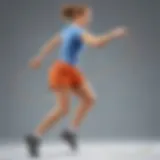Easter Egg Arts and Crafts for Young Creators
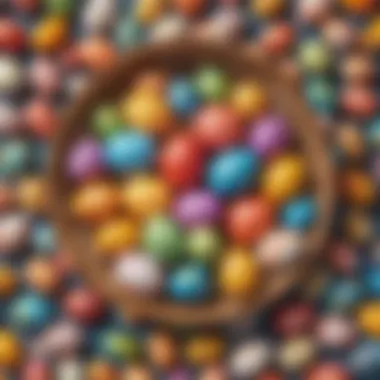

Intro
Easter is a time of joy, excitement, and, quite importantly, creativity! When it rolls around each spring, children find themselves with vibrant colored eggs, crafts dangling from the ceilings, and pastel decorations all over the place. But what makes this holiday truly special isn’t just the chocolate or the hunts; it’s the opportunity for young innovators to express themselves through arts and crafts. At the heart of this festive period lies the Easter egg – a canvas just waiting for children to unleash their imagination.
Engaging in arts and crafts does more than pass the time. It nurtures creativity, enhances fine motor skills, and can even help with problem-solving. Children aged six to twelve are at a prime age to explore their artistic sides, discovering new techniques and materials that can turn plain eggs into masterpieces.
Curious about the sorts of projects that await? From painting eggs to using unique materials like washi tape or natural dyes, the world of Easter craft is as rich as a chocolate egg hidden in the garden. This isn’t just about decoration; it’s about exploring ideas, learning techniques, and ultimately encouraging an innovative mindset.
As we navigate through various crafting projects, you’ll gain insights on how to facilitate these engaging activities at home or in classrooms, enabling a fun learning experience for kids and caregivers alike.
Prologue to Easter Egg Arts and Crafts
Embarking on a journey into Easter Egg arts and crafts offers a delightful way for children to explore their creativity while celebrating a culturally rich tradition. The process of decorating eggs for Easter has a history that spans across different cultures, each bringing its own unique flair and significance. This connection to the past not only ignites interest but also enables kids to appreciate the diverse customs of various communities.
The act of creating Easter-themed crafts is more than just a fun activity; it provides a platform for self-expression. As young innovators engage with various materials and techniques, they also learn essential skills that are crucial for their development. These projects teach children not only how to craft but also encourage them to think critically, problem-solve, and brainstorm innovative ideas.
In this article, we shall explore several creative avenues related to Easter Egg crafts. We will discuss everything from choosing the right materials to the techniques that can transform simple eggs into miniature works of art. Parents and caregivers are invited to join in the fun, allowing for shared experiences that strengthen bonds while fostering growth. It’s about making memories as much as it is about creating beautiful crafts.
"Crafting isn’t just about making things—it’s about the journey that comes with the process."
Through this exploration, the significance of Easter Egg arts and crafts will become clear, showing that they’re not only essential for creativity but critical for personal development in young children.
Materials Needed for Easter Egg Crafts
When it comes to crafting, having the right materials is crucial to achieving great results and ensuring a fun experience. For Easter egg projects, the choices one makes can influence creativity, safety, and the overall enjoyment of the activity. Children often express themselves through these crafts, so it’s essential to select materials that not only spark their imagination but also allow them to unleash their inner artist. Let's dive deeper into the various types of eggs and essential supplies required for these creative undertakings.
Choosing the Right Type of Eggs
Real Eggs
Real eggs present a traditional avenue for crafting and are steeped in cultural significance. Their natural shell texture adds a level of authenticity to any Easter decoration. However, they come with both pros and cons. On one hand, real eggs can achieve stunning, delicate designs that other materials may struggle to replicate. On the other hand, they are fragile—an important consideration for younger crafters who might not handle them carefully. Encouraging kids to take care of these real treasures can impart a valuable lesson in responsibility, but it’s wise to supervise closely to avoid any breakage.
Plastic Eggs
Now, plastic eggs are like the Swiss Army knife of Easter crafting. They are lightweight and durable, making them a safe option for little hands. With a myriad of colors and sizes available, plastic eggs offer versatility that aligns well with countless design ideas. Plus, they can easily be reused for future Easter celebrations or other crafting projects. The only downside? They lack that organic charm found in real eggs, but hey, sometimes practical beats pretty, especially when mess is a concern!
Paper Eggs
Let’s not overlook paper eggs either. These are excellent for fostering creativity, as kids can easily cut, fold, and embellish them without the fear of shattering shells. Paper eggs can be decorated with paint, markers, or even fabric scraps, making them a go-to choice for environmentally conscious crafters. While they’re not as robust as plastic options, their light weight allows for a wide range of creative applications. However, their tendency to crumple or tear means they might not hold up as well in an exuberant craft session, but they do shine in imaginative scenarios.
Essential Art Supplies
Paints and Brushes
Paints and brushes are the heart of any crafting endeavor. The vivid colors can bring an ordinary egg to life, enabling kids to express their artistic visions fully. Additionally, using various brush sizes helps develop fine motor skills in young crafters. Acrylic paints offer durability and a glossy finish, whereas watercolors allow for a softer look. One downside to consider is the cleanup; water-based paints wash away easily, but they can also create quite a mess if not supervised.
Markers and Pencils
Switching gears, markers and pencils present another straightforwardMedium for artistic expression. They inspire bold strokes without the need for water or additional supplies. Washable markers can be especially appealing for projects involving young kids since they can usually be easily wiped from surfaces. However, some markers may leave stains on eggshell, so a little caution in picking the right ones is wise!
Glue and Adhesives
No Easter egg project would be complete without glue and adhesives. These tools are fundamental for attaching decorative elements like feathers or sequins. Liquid glue offers versatility for a variety of materials, but it does take time to dry. Glue sticks are a speedy alternative, allowing for immediate bonding. Nonetheless, users should remember that not all glues are made equal—some could fail under pressure! Hence, finding a quality adhesive designed for crafts is paramount.
Optional Craft Materials
Stickers
Stickers are the cherry on top of any craft! They come in countless designs and can cater to various age ranges. Kids love picking stickers that resonate with their interests, making personalized creations unique. While they often glue on easily, be mindful—resilient stickers can still peel off if not firmly pressed. While not a substitute for traditional decoration methods, they offer a speedy solution to add flair.
Glitter
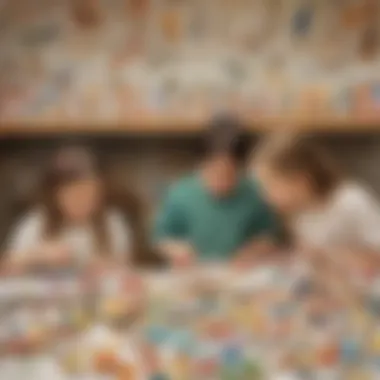

Glitter holds a special spot in every artist's heart; it’s like adding a sprinkle of magic to creations. Its shine can transform any design from plain to fabulous in no time. Crafting with glitter can help cultivate patience as one learns to manage it carefully. Just a heads-up though, it tends to venture beyond its intended borders; this can lead to an obligatory glitter cleanup!
Natural Dyes
Natural dyes bring an eco-friendly twist to Easter crafts. By using common kitchen items like beet juice, turmeric, or even red cabbage, kids can dive into an intriguing science project while crafting. This not only allows for vibrant color choices but also promotes discussions about sustainability. However, it’s crucial to bear in mind that results can be unpredictable, often leading to surprising color outcomes. It can be a double-edged sword, perfect for exploring creativity while educating about nature.
Techniques for Decorating Easter Eggs
Decorating Easter eggs isn't just a fun activity; it's an exploration of creativity that engages children in myriad ways. Various techniques provide unique results, encouraging kids to experiment and express their artistry. Each method presents its own set of challenges and benefits, fostering not just creativity, but also hand-eye coordination and fine motor skills. By learning about these techniques, children build confidence in their abilities, while also creating beautiful and individualized keepsakes.
Traditional Painting Techniques
Watercolor
Watercolor painting is a classic choice for Easter egg decoration. The beauty of watercolors lies in their ability to create soft, flowing colors that blend effortlessly. This technique invites young crafters to play with color mixing and layering, fostering an understanding of hues and shades. A significant benefit of watercolors is that they are easily wash-able, making them less intimidating for beginners. However, they require a certain finesse; the water-to-paint ratio needs to be just right, or the eggs might get too wet and lose their shape.
Acrylics
Acrylic paints are another popular option for decorating Easter eggs. These paints have a rich pigmentation and dry quickly, which means kids can layer colors without long waiting times. The versatility of acrylics allows for various finishes—from glossy to matte—giving creators room to experiment. That said, it’s wise to keep ventilation in mind, as the smell can be potent. Plus, cleaning up after using acrylics might be a bit trickier than watercolors, as they can stain surfaces quite effectively.
Dyeing Methods
Dyeing methods for Easter eggs are steeped in tradition. Using natural dyes, such as beet juice or onion skins, can be an educational experience, showcasing how colors in nature can be used for art. The process often yields vivid, unexpected colors that are as rewarding to behold as they are to create. Unfortunately, natural dyes tend to require longer prep time and a patient hand, which means they might be more suitable for slightly older craft enthusiasts. Nonetheless, the results are often worth the extra effort.
Applying Textures and Patterns
Decoupage
Decoupage is a fantastic method for adding intricate patterns to Easter eggs. Using cut-out images from magazines or tissue paper, children can layer these elements with glue to create a story or theme on each egg. This method encourages creativity, teamwork, and fine motor skills, allowing kids to think outside the box while being artistic. However, it may require some drying time between layers, and if not done carefully, the paper can tear or bubble.
Stamping
Stamping is a fun quick method that adds texture to Easter eggs. Kids can use rubber stamps or even their own unique creations to lightly press onto the eggs with paint or ink. This technique is inherently forgiving, allowing room for mistakes and experimentation. The limitations might include availability of stamps and ink, which means planning ahead is key. Still, stamping can yield some wonderfully quirky and personalized designs.
Spray Techniques
For those looking to add a modern twist to their Easter egg décor, spray painting is an innovative option. Whether using traditional spray paint or specially designed spray for crafts, this technique enables even coverage and vibrant colors. The spraying process can be exciting; however, children must be monitored closely during this activity, as over-spray can get messy quickly. Overall, spray techniques open the door to unique layering and effects that can't be achieved through traditional methods.
Innovative Decoration Ideas
3D Embellishments
Adding 3D embellishments can transform regular eggs into eye-catching masterpieces. Kids can use items like pom-poms, beads, or fabric scraps to build texture and depth. This not only sparks creativity but also supports fine motor skill development as children manipulate small objects. Keep in mind though, that these embellishments may make the eggs heavier and more cumbersome to handle.
Natural Elements
Incorporating natural elements, like twigs, leaves, or flowers, into egg designs brings a touch of earthiness and originality. Encouraging children to gather these items outside can turn the crafting into an engaging adventure. This method promotes an appreciation for nature and sustainability. Be cautious, though: some natural items can be delicate or perish quickly, so using them should be timely.
Electronic Components
For older kids looking to delve into technology, adding small electronic components like LED lights can take Easter egg crafting to a new level. This unique approach merges art with science, as children learn to create light-up eggs with minimal circuitry. The drawback is that it requires adult supervision and a bit more knowledge about electronics, which might limit its accessibility for younger kids. Still, it provides a fusion of creativity and learning that’s noteworthy.
Ultimately, the techniques for decorating Easter eggs can significantly enrich children's crafting experience. By exploring various methods, kids not only develop artistic skills but also gain confidence and joy in their creations.
Thematic Easter Egg Craft Projects
Creating themed Easter eggs is a delightful way for children to embrace their creativity. This section focuses on how thematic decorations enhance the crafting experience, sparking imaginations and encouraging young minds to explore concepts and narratives. Integrating themes into egg crafts not only promotes artistic expression but also offers a tangible connection to stories, animals, or even the seasons. When kids engage in thematic projects, they often immerse themselves in a world of ideas, making the crafting process both educational and fun.
Animal-Inspired Eggs
Bringing the animal kingdom to life through egg art can be an incredibly enriching experience for children. Animal-inspired designs allow kids to express their love for various creatures, from vibrant birds to adorable bunnies. Using a range of materials such as paints, feathers, or even fabric, children can transform plain eggs into colorful representations of their favorite animals.
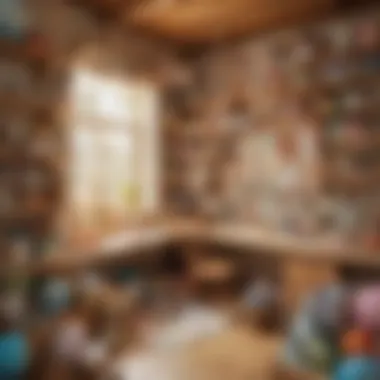

Consider the following ideas:
- Birds: Paint eggs to look like bright robins or elegant peacocks using vivid colors and creative patterns.
- Underwater Life: Dive into the ocean with designs featuring fish or turtles, utilizing blues and greens.
- Cute Pets: Capture the essence of beloved pets by crafting eggs that resemble furry friends like dogs or cats.
Engaging in this type of craft not only enhances fine motor skills but also fosters a deeper appreciation for nature. Kids can further delve into discussions about habitats, behaviors, and conservation, expanding their knowledge while having a blast.
Character and Story-Based Designs
Crafting eggs based on beloved characters or stories strikes a chord with many children. By linking crafting to characters from books, movies, or even folklore, children can engage with narratives they adore. This makes the project more than just a visual art task; it’s an opportunity to explore creativity through storytelling.
Ideas to consider:
- Fairy Tale Themes: Create eggs that depict characters like Little Red Riding Hood or Prince Charming, using paint and clay.
- Superhero Eggs: Let children channel their favorite superheroes by decorating eggs with capes and masks using colorful papers.
- Animated Characters: Encourage kids to reimagine eggs as characters from popular animated films, turning them into craft masterpieces that reflect their personal fandom.
Through these projects, children not only express their artistic flair but also develop narrative thinking by connecting visual art with storytelling. It’s a dual opportunity for creativity and literacy development.
Seasonal and Nature Themes
Seasonal changes offer a plethora of inspiration for crafting festive eggs. By selecting a specific season or natural element as a theme, children can create artworks that reflect various aspects of the environment around them.
Consider these themes:
- Spring Blooms: Use floral designs to celebrate the arrival of spring, incorporating pastel colors and even real petals.
- Fall Harvest: As autumn rolls in, children can depict pumpkins, leaves, and acorns, adding earth tones and textures to their projects.
- Winter Wonderland: Capture the chilly charm of winter with snowflakes and frosty colors, creating a magical atmosphere.
As children engage with these projects, they develop cultural awareness regarding the significance of seasons and nature. It’s also a unique chance to combine science with art, allowing kids to learn about the environment while exercising their creativity.
Safety Considerations in Egg Crafts
When it comes to crafting with Easter eggs, ensuring the safety of our young crafters is paramount. Children, especially those aged six to twelve, are eager explorers, but they can sometimes be a bit reckless as they dive into their creative projects. This section explores key safety considerations that guardians and educators should keep in mind to ensure a fun and secure crafting experience.
Choosing Non-Toxic Materials
One of the foundational aspects of promoting safety in egg crafting involves the thoughtful selection of materials. Opting for non-toxic supplies not only protects children from potential harm but also fosters a healthy atmosphere for creativity. Here are a few categories to consider:
- Paints: Look for options labeled as kid-safe or non-toxic. Some brands utilize natural pigments, which can be safer for young hands and minimize risks if some paint accidentally finds its way to their mouths.
- Adhesives: Choose glue that is non-toxic and washable. This makes clean-up easier and provides peace of mind that even if some glue ends up on their skin, it won't pose a health risk.
- Dyes: Natural dyes derived from plants can be a fantastic alternative to conventional dyes, offering colorful results without nasty chemicals.
By choosing the right materials, you not only prioritize health but also teach children the importance of being mindful about what they use in their projects.
Supervising Young Crafters
Supervision is another significant element of safety during egg crafts. Children can easily get lost in the excitement and overlook the dangers, which is why keeping a watchful eye is crucial. Here are several key points regarding supervision:
- Active Engagement: Rather than simply overseeing, actively engage with the children as they craft. Ask questions about their ideas or encourage them when they are stuck, creating a more connected and safe environment.
- Set Boundaries: Establish clear guidelines regarding the use of materials and tools. For instance, if scissors are involved, explain when and how to use them safely. You may want to designate specific areas for messy activities as well.
- Stay Present: Remain nearby, particularly during intricate tasks. It's easy for small accidents to happen, so being close allows you to intervene quickly if needed.
Supervision not only enhances safety but also enriches the crafting experience, helping children learn not just the craft itself, but responsibility and caution too.
"Safety is not simply a priority; it's a commitment to creativity without fear, letting imagination soar while keeping little ones safe."
In summary, crafting with Easter eggs offers incredible opportunities for creativity and learning. However, remembering to prioritize safety through non-toxic material choices and vigilant supervision enables a worry-free atmosphere where children can truly thrive in their artistic pursuits.
Integrating Learning with Arts and Crafts
Arts and crafts offer a treasure trove of learning opportunities for young minds. When it comes to Easter egg projects, the integration of creativity and educational aspects forms the backbone of these activities. Not only do kids get to unleash their artistic side, but they also engage in a holistic learning experience that touches on various essential skills.
Encouraging Creativity and Imagination
At the heart of creating Easter eggs is the power of imagination. Children are naturally curious, and craft projects like these allow them to explore their creative bounds. By providing materials like paints, stickers, and embellishments, caregivers and educators can ignite a spark of originality in kids. They can envision unique designs, incorporating vibrant colors or even abstract patterns. This process nurtures an environment where creative expression flourishes.
"Creativity is intelligence having fun." - Albert Einstein
When children feel free to express themselves, they're more likely to think outside the box. Projects like animal-inspired eggs or seasonal themes can lead to imaginative storytelling, where kids invent narratives about their creations. Encouraging such creativity not only makes the crafting experience enjoyable but also builds their ability to think innovatively.
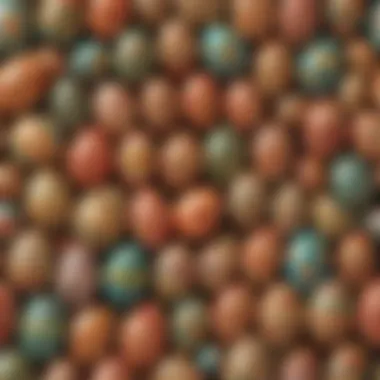

Developing Fine Motor Skills
Easter egg crafts serve as a delightful way to practice fine motor skills, crucial for young children's development. Whether it’s painting intricate designs, using scissors to cut out patterns, or pasting decorations, kids are essentially training their hands and fingers to become more precise. These activities also enhance hand-eye coordination, as children learn to navigate their tools effectively.
Consider incorporating tools like paintbrushes of different sizes or intricate stampers. By using these, kids will feel challenged yet eager to improve their dexterity. The sense of accomplishment they gain from mastering these skills is immeasurable, instilling confidence that spreads beyond arts and crafts.
Understanding History and Culture
Beyond the fun of decorating eggs, there lies a rich tapestry of cultural significance and historical context that can be woven into the crafting experience. Easter eggs have been embraced by various cultures around the world, with each tradition contributing unique meanings and practices.
For instance, the custom of decorating eggs during Lent can be tied to notions of rebirth and renewal across many societies. Teaching children about these traditions exposes them to diverse cultures and perspectives, fostering respect and understanding for others. Engaging kids in discussions about the history of Easter eggs can be both enlightening and enriching.
These narratives can seamlessly blend into crafting sessions, transforming a simple activity into a profound learning experience. Kids might find themselves wondering about how people celebrate Easter in different parts of the globe, prompting not only creativity in their craft but also curiosity about the world around them.
Showcasing Completed Projects
Showcasing completed projects holds substantial significance in the realm of Easter egg arts and crafts. This stage is not just about displaying finished creations; it's an act of celebration that encapsulates creativity and learning, providing various benefits for young innovators and their guiding adults. It can embolden kids by validating their efforts, nurturing a sense of pride and accomplishment. Moreover, sharing their artworks encourages social interaction, which can be particularly beneficial for developing essential communication skills.
When children gather to display their crafted eggs, it becomes a moment for them to articulate their ideas and the thought processes behind their designs. By explaining their choices in colors, materials, and techniques, children engage in critical thinking and practice expressing themselves clearly, which are skills beneficial later in life. Additionally, these exhibits can foster a nurturing environment; when peers, parents, and teachers admire their handiwork, a child’s self-esteem gets a substantial boost.
There are various ways to showcase these arts and crafts projects. From informal displays at home to more structured events, the possibilities are quite broad. Here are some key points to consider when planning how to share these creative efforts:
- Invite Family and Friends: Encourage children to invite family or friends to view their work, creating a supportive audience that appreciates their creativity.
- Create a Gallery Space: Designate a specific area in the home or classroom to exhibit the crafted eggs, giving each piece its own space to shine.
- Celebrate Diversity in Art: Recognize that every child’s creation is unique. Showcasing a variety of styles can highlight different perspectives and techniques.
Ultimately, the act of showcasing completed projects within Easter egg arts and crafts serves to enrich children's crafting experiences, providing both personal and social rewards.
Organizing a Craft Exhibit
Organizing a craft exhibit can amplify the excitement and importance of showcasing completed projects. It provides an excellent opportunity for young crafters to present their eggs in a structured environment, encouraging them to take ownership of their creations. Here’s how to go about it:
- Choose a Venue: Decide whether the exhibit will take place at home, in a community center, or even at school. The location can impact the scale and participation.
- Set a Date: Pick a date that allows enough time for the children to prepare. Inform all invited guests well in advance.
- Prepare Your Setup: Gather necessary materials for display, which might include tables, easels, or shelves. Consider how each egg will be presented attractively.
- Promote the Event: Use simple flyers or social media posts to invite peers and parents. Building anticipation can be engaging.
- Select Display Features: Choose how to title each piece. Kids can write a simple description about their artwork and the inspiration behind it.
This structured approach not only elevates the experience for the children but also creates an unforgettable memory.
Documenting the Process
Documenting the process of creating art projects is also a valuable component of showcasing completed projects. This practice can take many forms, such as keeping a journal, an online blog, or even video diaries. Here are some thoughts:
- Capture Progress: Encourage children to take photos at different crafting stages. This visual record can serve as a meaningful reflection on their artistic journey.
- Reflect on Techniques Used: Children can jot down or verbally discuss what techniques they employed and what challenges they faced during the process.
- Celebrate Learning Moments: Documenting can highlight learning achievements, such as problem-solving and innovative thinking. It gives children a chance to see how they have grown in their creative abilities over time.
- Share with Others: This documentation can further enrich the exhibit by providing context around each piece of art during the showcase.
"Art is a journey, not a destination; keep a record of your adventure!"
By prioritizing documentation, not only do children gain insights into their own creative processes, but they also take pride in their accomplishments, paving the way for future innovative endeavors.
End: Embracing Creativity Through Egg Crafts
As we reach the end of our exploration into Easter egg arts and crafts, it becomes clear that the significance of these creative endeavors extends far beyond mere decoration. Engaging in egg crafts offers children an invaluable opportunity to express themselves while developing essential skills that will serve them well into adulthood.
A Canvas for Imagination
When children pick up a paintbrush or glue to create their Easter eggs, they are not just following instructions; they are transforming simple materials into a canvas for their imagination. This artistic process encourages kids to experiment with colors and shapes, allowing them to make personal choices. They can go wild with designs or stick to traditional patterns—it’s all about choice. This level of self-expression helps cultivate a sense of autonomy.
"Creativity is contagious, pass it on." – Albert Einstein
Building Problem-Solving Skills
Arts and crafts like these also present unique problem-solving challenges. Kids may encounter difficulties, like how to prevent the paint from smudging or how to best apply textures without overwhelming their egg designs. Finding solutions to these problems fosters resilience and critical thinking. For instance, they might discover through trial and error that using a sponge for painting yields more visually appealing results than a brush. This hands-on experience deepens their understanding of cause and effect, reinforcing cognitive development.
Nurturing Social Skills
Moreover, working on egg crafts can be an excellent group activity. When children collaborate, they learn the importance of communication and teamwork. Perhaps they could set up a crafting session with friends or siblings, where they share materials and ideas, learning to compromise and negotiate in the process. Such interactions are vital, as they teach children how to express their thoughts and respect others’ opinions.
A Gateway to Learning
Let’s not ignore the educational aspect of the project. Each egg represents an opportunity for young learners to explore aspects of history, culture, and even science. From understanding the significance of Easter eggs in various cultures to discussing the properties of different crafting materials, these projects can spark conversations that lead to deeper understanding. Each craft session might start with eggs, but the discussions that arise can take them on a learning journey far beyond the initial goal.
Last Words
While we’ve covered a good deal, the true beauty of these projects lies in the endless possibilities they offer. So, roll up those sleeves, gather your materials, and let the creativity flow! There's always more to explore in the world of crafting!




